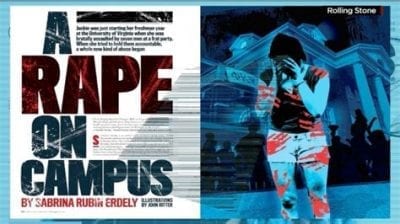In a now-infamous story in Rolling Stone, disgraced journalist Sabrina Rubin Erdely asserted that at least five members of the Phi Kappa Psi fraternity gang-raped a freshman named Jackie at a frat house party, then left her in a bloodstained dress to exit via a conveniently vacant side staircase.
Shortly after it was published, details of the article were brought into question resulting it having since been labeled a hoax. Eventually, Rolling Stone retracted the piece and apologized. Former University of Virginia associate dean of students Nicole Eramo claimed the article portrayed her as a villain who discouraged “Jackie” from reporting the incident to police.
Two years later a federal jury found the magazine and reporter Sabrina Erdely liable in a $7.5 million defamation lawsuit due to the fake news report. Rolling Stone would pay all of Erdely’s legal costs and any penalties that may be levied against her, according to the Associated Press.
Why did Erdely commit career suicide? Writing at Slate, Hanna Rosin provides the likely answer: Erdely hoped her wildly implausible 9,000-word, agenda-driven excuse for journalism would emphasize “the larger theme of a university culture and social scene indifferent even to the most brutalized victims of rape.”
This motive explains why Erdely went to such great pains to present Jackie’s friends weighing whether to rush a gang-rape victim to the hospital. Sure, it might be good for Jackie, but would such a move devastate their social reputations on frat row?
Whatever Erdely’s motive, her discredited piece raises the question: Is it remotely true that American college administrators and college students are indifferent to the allegations of rape victims? What about the exponential growth of rape activism on campus? What about the routine occurrence of “take back the night” vigils? Could this perceived indifference actually be warranted skepticism? In fact, the number of completely fraudulent rape allegations made by women on American college campuses is far from trivial.
The fake news that saw innumerable people accused of rape at college campuses across America, claims that were proven wrong, ruined people’s lives and perpetuated the myth (fake news) that one in five women are raped on college campuses.
The shock claim that “one in five women on college campuses have been sexually assaulted” has been parroted by politicians — including former President Obama — who are hoping to score points defending women in a supposed war against them. But in reality, this claim is misleading at best. It has been debunked multiple times, but apparently the paranoia it causes is just too good to let facts get in the way, so I am going to debunk it again.
The statistic comes from a 2007 Campus Sexual Assault study conducted by the National Institute of Justice, a division of the Justice Department. The researchers made clear that the study consisted of students from just two universities, but some politicians ignored that for their talking point, choosing instead to apply the small sample across all U.S. college campuses.
The CSA study was actually an online survey that took 15 minutes to complete, and the 5,446 undergraduate women who participated were provided a $10 Amazon gift card. Men participated too, but their answers weren’t included in the one-in-five statistic. If 5,446 sounds like a high number, it’s not — the researchers acknowledged that it was actually a low response rate.
“Another limitation of the CSA study, inherent with Web-based survey, is that the response rates were relatively low,” the researchers said. “Although the response rates were not lower than what most Web-based surveys achieve, they are lower than what we typically achieve using a different mode of data collection (e.g. face-to-face interviewing).”
Nineteen percent of women who responded to the survey said they had experienced some kind of sexual assault, either attempted or completed (12.6 percent reported attempted sexual assaults, 13.7 percent reported completed sexual assaults and some women reported both).
But a lot of those responses have to do with how the questions were worded. For example, the CSA study asked women whether they had sexual contact with someone while they were “unable to provide consent or stop what was happening because you were passed out, drugged, drunk, incapacitated or asleep?”
The survey also asked the same question “about events that you think (but are not certain) happened.”
That’s open to a lot of interpretation, as exemplified by a 2010 survey conducted by the U.S. Centers for Disease Control and Prevention, which found similar results.
Like the CSA survey, the CDC survey had a low response rate and nonrepresentative sample. As Christina Hoff Sommers of the American Enterprise Institute notes, “No one interviewed was asked if they’d been raped or sexually assaulted.
“Instead of such straightforward questions, the CDC determined whether the responses indicated sexual violation,” Hoff Sommers said.
The CDC survey also asked a question about sexual contact while “drunk, high, drugged or passed out and unable to consent.” The question did not make it clear that it applied only to instances of unwanted sexual contact.
“Now, 61.5 percent of the women the CDC projected as rape victims in 2010 experienced what the CDC called quote ‘alcohol and drug-facilitated penetration,’ ” Hoff Sommers said. “If a woman was unconscious or incapacitated, then every civilized person would call it rape.”
“But what about sex while inebriated?” Hoff Sommers continued. “I mean, few people would say that intoxicated sex alone constitutes rape, indeed a nontrivial percentage of all customary sexual intimacy — including marital sex — probably falls under that definition.”
Glenn Kessler of the Washington Post, who fact-checked the CSA study back in May, pointed out that similar studies from 1997 produced different results based on how the questions were worded.
He cited an NIJ fact sheet which noted that “researchers have been unable to determine the precise incidence of sexual assault on American campuses because the incidence found depends on how the questions are worded and the context of the survey.”
And actual reported crimes are much lower. Bureau of Justice Statistics data indicate that in 2012 the rate of rapes and sexual assaults was 1.3 per 1,000 Americans ages 12 and up.
Even though the Rape, Abuse and Incest National Network estimates that 60 percent of all sexual assaults go unreported, the difference between actual reports and the oft-cited study results is even greater, casting even more doubt on their veracity.
Nevertheless, eight senators are using that false statistic to push legislation aimed at combating campus sexual assault, and their bill calls for an annual online survey that would use methodology similar to the other surveys that have already been discredited as inaccurate or misleading. Criminologists James Alan Fox and Richard Moran warned Sunday in USA Today that this new survey would be harmful for all colleges.
“What makes this ill-conceived survey of such concern is that the results are to be publicly released, with rates reported for individual schools. This carries significant implications for admissions and retention rates, as it is based on data of highly questionable validity,” Fox and Moran wrote. “Indeed, flawed data are sometimes worse than no data at all.”
So far, of the eight Senate co-sponsors of the legislation, only Sens. Marco Rubio, R-Fla., and Chuck Grassley, R-Iowa, have answered questions from the Washington Examiner about the bill’s required annual survey, but their responses did not provide assurances that the surveys would be objective and nonpolitical.
The truth is, we don’t know how many women have been sexually assaulted on America’s college campuses, but legislation based on overblown statistics won’t lead to safer campuses, just more fear.
Sources:



